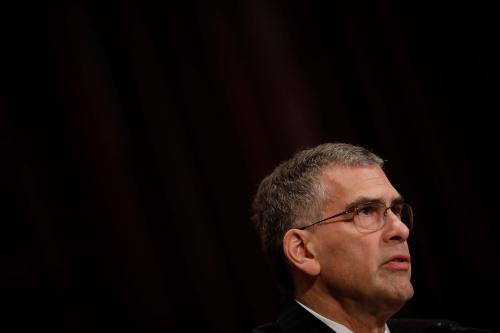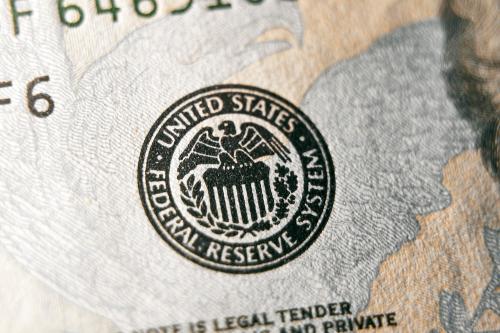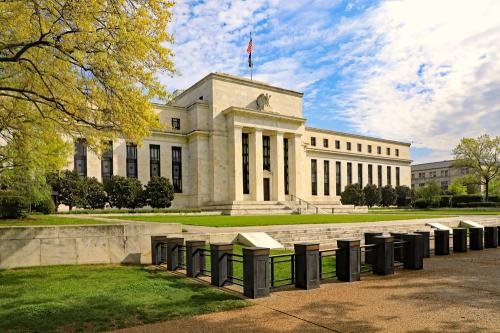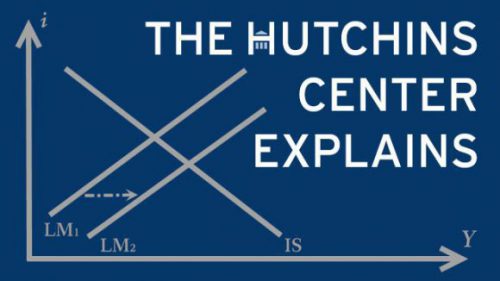Later this year, the Federal Reserve plans to begin a review of the statement of longer-run goals and monetary policy strategy that it adopted in August 2020. In anticipation of that, the Hutchins Center on Fiscal & Monetary Policy at Brookings convened a conference in June 2024 to offer the Fed advice about what should be on the agenda for that review. The Fed has promised to review its “monetary policy strategy, tools, and communication,” the focus of the Brookings conference.
Michael Kiley, deputy director of the Fed’s Division of Financial Stability, presented his work on optimal monetary policy. Michael Bauer of the Federal Reserve Bank of San Francisco responded. Anna Cieslak of Duke presented a paper, written with co-authors Michael McMahon of Oxford and Hao Pang of Duke, on how Fed communications influence interest rates. Eric Swanson of the University of California, Irvine, responded. Following those presentations, Don Kohn of Brookings, McMahon, Christina Romer of the University of California, Berkeley, and Brian Sack of Balyasny Asset Management offered their views on what the Fed should consider as it undertakes the framework review.
This post draws eleven lessons for the Fed from those papers and discussions. A video of the conference and conference drafts of the papers are available here.
Lesson 1: Adopt a robust framework that works across a wide array of shocks and is not targeted at one specific problem.
When the Fed unveiled its current framework in August 2020, inflation had been persistently running below 2%. Fed policymakers worried that markets and the public would expect inflation to run below its target and that the Fed’s key short-term interest rate would frequently fall to zero—the “zero lower bound,” or ZLB—limiting the Fed’s ability to cut rates to stimulate a sluggish economy. As such, “the framework review did seem too specific to the problem of the day,” noted Brian Sack. As Christina Romer stated: “The problem was setting up a framework that almost didn’t even recognize that you could end up in a place where you could have very high inflation.”
Don Kohn said the Fed should craft a framework that is “robust to a variety of circumstances”—periods of high inflation, as well as the ZLB—and not “just aimed at what we’ve recently lived through.”
Sack described the ideal framework this way:
If you think you want a framework that’s robust to a variety of economic situations, a variety of policy challenges, I think the pieces of it that are robust are 1) inflation should average 2%, and 2) policymakers should be aggressive enough to keep inflation expectations near 2%.
Lesson 2: Reevaluate the asymmetries built into its reaction function.
The Fed built two asymmetries into its framework to offset the potential adverse effects of hitting the ZLB. They are part of the Fed’s reaction function—how the Fed expects to respond to changes in the economy.
The first asymmetry is the Fed’s approach to inflation targeting, known as flexible average inflation targeting (FAIT). With FAIT, the Fed promises to respond more forcefully to inflation when it falls below 2% by holding inflation “moderately above 2 percent for some time” than when inflation is above 2%.
The second is the Fed’s approach to employment, which is to “mitigate shortfalls of employment from the Committee’s assessment of its maximum level.” In other words, the Fed “will not tighten monetary policy solely in response to a strong labor market.” Before 2020, the Fed statement implied that it would raise interest rates when unemployment fell to a level that history suggested would put upward pressure on prices. It said that it sought to mitigate “deviations of employment from the Committee’s assessments of its maximum level.”
In his two papers, Michael Kiley questioned the asymmetries, arguing that they contributed to the Fed’s delay in raising interest rates in recent years. Kiley demonstrated that a symmetric reaction function, by restraining the economy when it is strong, generates better labor market and inflation outcomes by reducing the overall volatility of the economy:
Symmetric policy reaction functions mitigate the most adverse types of employment shortfalls by contributing to economic stability… Asymmetric approaches can exacerbate economic activity and actually be counterproductive.
He also warned that the ZLB “remains a significant constraint hindering the achievement of price stability and full employment.” Kohn agreed, stating that “you don’t need the asymmetry” but that the framework must account for “a return to risk of hitting the zero lower bound again.”
However, there are potential benefits to an asymmetric policy response, as Michael Bauer argued:
Running a hot economy can raise employment and lower [the] unemployment rate in the longer run… If you focus on shortfalls and this raise[s] long-term inflation expectations a little bit, this could kind of undo [a persistent undershooting of inflation].
Lesson 3: Define maximum employment and how that is consistent with price stability.
In its strategy statements, the Fed has not explicitly defined “maximum employment,” which, along with price stability, is one of the two goals that Congress has assigned the Fed. In the current framework, the Fed states that “the maximum level of employment is a broad-based and inclusive goal that is not directly measurable and changes over time owing largely to nonmonetary factors that affect the structure and dynamics of the labor market. Consequently, it would not be appropriate to specify a fixed goal for employment.”
Don Kohn argued for defining maximum employment to be consistent with the Fed’s price stability mandate:
I think a really key point about maximum employment is it has to be consistent with price stability. I’d like to see that included in the strategy itself. Yes, running the labor market hot is great, and it helps certain groups more than others… But it’s not the Fed’s job to make up for various inequities in society. It’s really hard to hit those two goals [of price stability and maximum employment]. And I think defining [the] maximum employment goal so it’s consistent with the price stability goal would be helpful in focusing [the Fed] where they need to be.
Lesson 4: Reevaluate the 2% inflation target, but don’t change it yet.
In 2012, the Fed publicly announced an inflation target of 2%.
Economists differ on the wisdom of the 2% target. Some advocate increasing the 2% target to 3% or 4%; others argue that the target should be kept where it is because it is a widely accepted definition. Some have called for setting a range—say, 1.5% to 2.5%—rather than a single number. In a recent Hutchins Center survey of Fed watchers, two-thirds of respondents said that the Fed should not increase the 2% target.
Don Kohn said that the Fed should examine its 2% target, stating:
Maybe it’s the right goal. But I think it would be very helpful to the commitment of the central bank and the understanding of both the financial markets and general public to know if they end up at two, why two is the right goal… [Many] academics would make it higher. The general public would make it lower. Where do you end up, and why did you end up [there]?
If the Fed does decide to change its target, it’s important to wait until it has successfully brought inflation down to 2%. Michael McMahon said:
Rightly or wrongly, 2% was chosen. To change [the target] now, I think, from the communication side would be a much harder ask. If you changed it when inflation just happened to be at 3 (or 3 and a half) and you said that’s the new target, it looks like you’re shifting the goalposts. Otherwise, what you have to do is the hard work of getting [inflation] back to two, then announce you’re going to change [the target] to three and a half, and then you have to work [inflation] back up again. That’s the right way, I think, to sequence it if you want to change [the target], but that’s a lot of work, and you’d have to trade off the risks that come with [this change].
Lesson 5: The Fed needs a better communication strategy.
Central bankers have come a long way in communicating to the public since the 1980s, when Chair Alan Greenspan took pride in his capacity for “mumbling with great incoherence,” and the Fed didn’t even announce when it had decided to change interest rates. Policymakers now view communication as an important monetary policy tool and have worked to improve their communication and transparency. The aforementioned Hutchins Center survey found that Fed watchers give the Fed strong marks for its current communications.
However, communications mishaps hampered the Fed’s effectiveness in combating inflation recently. Anna Cieslak argued that “there can be a Fed-induced uncertainty channel that operates due to communication failures that can raise term premia against policy intentions.” During the pandemic, the market reaction to what Fed officials said undid some of the Fed’s work, putting upward pressure on long-term rates. As such, Cieslak noted:
What we would definitely recommend is to spend effort and [conduct] research on figuring out [a] theory of optimal communication design, and also have quantitative evidence of the successes and failures of different communication [approaches].
Lesson 6: Articulate when and how forward guidance will be used—and include escape clauses.
Forward guidance is when a central bank shares its plan for the path of interest rates with markets and the public. The Fed’s use of forward guidance was an initial success, according to Anna Cieslak, anchoring short-term inflation expectations. However, in their Brookings conference paper, Cieslak, McMahon, and Pang argue that the policy was a failure overall, as it constrained the Fed from taking prompt action to fight inflation. Brian Sack agreed, arguing that the Fed’s strong use of forward guidance was too aggressive and lacked flexibility.
I think the real problem was in the structure of the guidance: exactly how the conditioning was put in place in terms of the economic variables that would be associated with liftoff [raising rates]. And specifically, the guidance talked about conditions for both inflation and employment—with an ‘and,’ which is very important. Inflation had to get above 2% and employment had to get to full employment; both of those conditions had to be met for liftoff to take place. In the circumstance where inflation was rising and inflation forecasts were moving up pretty rapidly, [the Fed] got stuck because the full employment condition had not been met, and that led them to stay at the lower bound for too long.
To improve its forward guidance in the future, Sack suggested that the Fed make sure guidance does not overly constrain policymakers from responding to unforeseen changes in the economy. Escape clauses—being able to pivot policy without losing credibility—are key:
I think forward guidance is a very powerful tool that can be used in particular circumstances where it’s extremely valuable. I think the lesson is [to] be much more careful with the conditioning assumptions [with] forward guidance and make sure they don’t box you in… Make sure [the forward guidance] is structured in a way that’s appropriate and doesn’t lock you in too much.
Lesson 7: Clearly communicate the reaction function.
Eric Swanson said that the “flexible average inflation targeting framework was a giant step backward in clarity and communication and accountability.” The A (average) in FAIT made it difficult for markets and members of the public to understand how the Fed would respond to varying economic conditions.
Sack also criticized the introduction of the A. He said that when interest rates hit the ZLB, the Fed should have said that it would strive to generate sufficient inflation so that it averages 2% over the business cycle. Swanson argued that the Fed should keep the communication simple:
By having such a simple framework where you just have to hit the inflation target, all the explanation should be about what [the Fed] is doing and why it’s related to the inflation target.
Another option that could improve communication of the reaction function is to use scenario analysis, which Cieslak, McMahon, and Pang advocated, and which was a recommendation in Ben Bernanke’s 2024 review at the Bank of England. With scenarios, policymakers explicitly lay out possible outcomes—such as stickier than expected inflation, geopolitical or trade turmoil, or weaker than expected labor markets—and detail how they would respond to these concerns. Cieslak, McMahon, and Pang said:
[Scenarios] can help explain the current economic assessment and circumstances that would cause policymakers to change that assessment. They can communicate the reaction function. Finally, by presenting a range of scenarios, the FOMC could communicate uncertainty, with individual policymakers using their own scenarios to present the range of views held.
Lesson 8: Improve communication with the public.
Monetary policy is a technical subject, and central banks are most often in the spotlight when things go wrong. Nonetheless, McMahon argued that the Fed should make greater efforts to engage and communicate with the public:
I think there are really good reasons why central banks should be trying to [communicate with the public], and it’s not just about managing inflation expectations. The idea of building trust and making the case for independent, technocratic, non-elected policymakers [is] really important [to make]… The Bank of England, I think, and the ECB are both ahead of the Fed in this. If you go to their websites, there’s an attempt to complement technical monetary policy statements with pictures… designed for people to understand.
The big challenges for the Fed to overcome, in McMahon’s view, are engagement and clearly articulating the complex details about monetary policy that matter:
If you give a normal person a choice of reading a Fed statement or watching a Fed press conference or watching cat videos on YouTube, they’re going to choose the cat videos almost every time. [In addition,] there’s a lot of research going on at the moment about how [central bankers] can [communicate with the public], what gets through. One [thing] that I think is worth mentioning is ‘what is the complexity that matters’… [In the typical central bank statement], there are no link words for normal people who don’t have an economic model in their head to form a narrative, and then this confuses people. And so there’s a lot that we have to do if you want to communicate with the general public and we’ll probably fail, but we should continue trying.
Lesson 9: Reevaluate the dot plot.
The dot plot—released in the Fed’s quarterly Summary of Economic Projections (SEP)—shows projections for the federal funds rate, the Fed’s main short term interest rate, for each member of the Federal Open Market Committee—but doesn’t identify them. Proponents of the dots believe that they are a powerful form of forward guidance, providing valuable information and insight to markets about the Fed’s thinking. Critics believe that the markets fail to properly understand the dots, taking the median dot as a promise, and that the forward guidance provided by the dot plot is too strong, underestimating the uncertainty inherent in making predictions about the future. The Hutchins Center survey of Fed watchers found that 55% of those surveyed said the Fed should keep the dot plot, and 27% said the Fed should kill it.
Christina Romer said she “might favor getting rid of the dots,” arguing that doing so might increase the Fed’s effectiveness.
I think there’s so much misinterpretation of the dots. Let’s look at the median, [which] tells us how many [rate] changes the Fed is going to make over the next year. There’s often a range, often the median is a really close call. And so, I think it gets misinterpreted. I think [the dot plots] also [impact] forward guidance. It is like you’re always doing forward guidance [with the dots]. And sometimes you don’t want to be doing that much forward guidance.
The one problem the Fed has is nimbleness. I think they’re so worried about surprising financial markets that it just gets to be like an oil tanker in terms of changing policy. And so I think the dot plots are yet one other reason for [not moving] so fast. I think we ought to be thinking about how [we could] get more nimbleness into monetary policy.
Brian Sack, on the other hand, was a passionate defender of the dot plot. He said that the markets understand the dots and do not take them as a promise.
I love the dots. I’m not ashamed of it. I think [the dot plot] is a very effective communications device. I agree that there’s a tremendous amount of uncertainty around what’s the most likely outcome for the economy. I agree the median is not, you know, a perfect summary statistic, but the dots are very valuable. The whole forecast is very valuable because it’s quantitative… I guarantee you [the dot plot] is the first thing everyone looks at on FOMC day. So, I think it’s a good communications device. Could it be improved? Sure… But it’s effective.
I don’t think [the markets] take [the dot plot] as a promise. I think the markets understand that [the dot plot] is a forecast and there’s a lot of uncertainty around it.
McMahon and Kohn both offered qualified support for the dot plot and its usefulness but suggested ways to make it even more useful. McMahon suggested that connecting the dots—linking the interest rate outlook to each FOMC participant’s economic forecast—might improve the dot plot.
When you have some disagreement or very uncertain times, the median may be a path that nobody likes. It could literally be a divisive path. I would support if [the dots] were connected in some way because you could then see some of the different views on paths and you transmit some of the uncertainty, which I think is important to do. And I think it’s important you communicate in a way that makes clear these are not commitments or promises.
Kohn cautioned Fed officials against the Fed’s practice of publishing— and highlighting—the median forecast.
I don’t think there’s enough acknowledgment of uncertainty. And the medians are part of the problem. People focus on the medians, not only of the dots—that’s most of the focus—but also, for inflation and growth and the unemployment rate. I wouldn’t publish the medians. I know people outside [of the Fed] would calculate the median. But it’s different when someone else is doing it. And by the same token, I think the chair and the committee need to be careful not to grab the medians and make them the focus of communication.
Lesson 10: Discuss the use of quantitative easing in the framework.
The Fed introduced quantitative easing (QE)—central bank purchases of long-term bonds to put downward pressure on long-term interest rates—in 2008 during the Global Financial Crisis to spur demand in the economy when short-term rates hit the ZLB. QE is now part of the standard central bank toolkit, but it isn’t mentioned in the Fed’s framework statement or in the quarterly Summary of Economic Projections. Brian Sack argued that the Fed should incorporate QE into its new framework:
I think if we’re going to use QE as a viable policy tool, the lessons are we need better calibration, better communication, and better clarity of purpose. We should hold [QE] to the same standards that we hold the fed funds rate to, which is, we should understand the reaction function and what’s driving the decisions. Related to that, there should be more communication about the QE reaction function. It’s just kind of turned on and left in the background and then eventually turned off.
To do so, Sack noted that the Fed must consider how QE has been used for different purposes, differentiating between market functioning QE—used to improve the functioning of financial markets—and monetary QE—used to lower long term interest rates:
QE can help to restore market functioning [when markets are disrupted and not functioning well]. In [March] 2020, there was a flight from treasuries because everyone was trying to liquidate. The market wasn’t functioning well by a number of measures. By buying Treasury securities, the Fed restored some balance and made the market function better. You can [also] use QE to lower [long term] rates, [making] financial conditions more accommodative even when markets are functioning fine.
Lesson 11: Provide an interpretation of the pandemic-era inflation episode, including what happened, what went wrong, and what went well.
Economists disagree about the recent performance of the Fed and role of its framework in failing to prevent and then fighting post-pandemic inflation. Don Kohn, with Gauti Eggertsson of Brown, Michael Kiley, and Anna Cieslak, Michael McMahon, and Hao Pang have argued that the Fed’s framework constrained it in responding appropriately to inflation as it emerged. Cieslak, McMahon, and Pang, for instance, wrote that the Fed made strong promises about interest rates and asset purchases, preventing them from preemptively tackling inflation before it was too late:
The Fed appears to have been constrained by the [2020] framework and the forward guidance, even though such constraints were perhaps not perceived as material by policymakers in real time. The need to build credibility for the newly announced strategy and to respect the forward guidance commitments led to deemphasizing risk management, which had historically played a large role in the Fed’s decision-making. As a consequence, the Fed became less sensitive to upper inflation tail risks relative to its past behavior, delaying action as the data started to diverge from the dominant scenario it assumed.
Eric Swanson disagreed. He argued, based on Fed forecasts in the SEP, that it “[did] not look like the FOMC was constrained; [it looked] like they thought inflation would be transitory.” Kohn said the Fed should clarify where it stands on the recent inflation episode:
I would start with lessons learned… It’d be great to have an interpretation from the Federal Reserve. How do we read what happened? What were the problems? What did we get wrong? What did we get right?
-
Acknowledgements and disclosures
The Brookings Institution is financed through the support of a diverse array of foundations, corporations, governments, individuals, as well as an endowment. A list of donors can be found in our annual reports published online here. The findings, interpretations, and conclusions in this report are solely those of its author(s) and are not influenced by any donation.









Commentary
Advice for the Federal Reserve’s review of its monetary policy framework
July 10, 2024